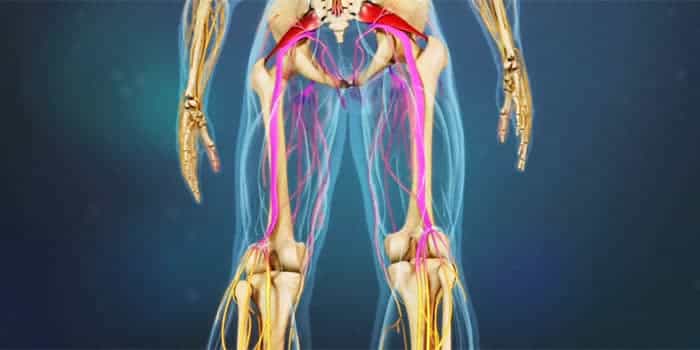Sciatica Symptoms & Signs
Sciatica is a condition in which the sciatic nerve or any of its roots or branches is compressed, resulting in pain in the lower back and buttocks, and sharp shooting pain in the leg, usually in one side.
Let us look at the anatomy of the sciatic nerve first. The sciatic nerve arises from the lumbosacral plexus. The sciatic nerve is a huge nerve that comes from L4, L5, S1, S2 and S3. There are five nerve roots and each one has its own dermatomal distribution.
When a nerve is compressed, it gives pain and symptoms in a specific area. This is an example when the L5 nerve root is compressed. You can see that the top of the foot is involved in the sensory deficit. However, the most common disc herniation is between L5 and S1 and that would affect the S1 nerve root, which is the lateral side of the foot. If the L4 nerve root is involved, then he can get the medial side of the foot involved. Dermatomes are important in knowing at which level is the herniation of the disc, but for the diagnosis of sciatica that really is not very important because what matters is the pain in the lower back and buttock area is shooting down the leg.
What is the course of the sciatic nerve? The sciatic nerve runs from the lumbar spine through the buttocks, and down to the leg and foot. The sciatic nerve runs predominantly in the posterior aspect of the buttock and the lower extremity.
With regards to symptoms and signs, there is sharp, shooting pain down in the buttocks, thigh and leg, usually on one side of the body, with numbness, tingling and burning. The area of symptoms and pain usually depend on the nerve that is involved. Sitting can aggravate the pain. It is almost like you are doing a straight leg raising sign, tensioning the nerve. You are lengthening the nerve. You are stretching the nerve and that is why you get pain on sitting. Also, coughing, squeezing and moving can aggravate the pain. The pain will improve by standing.
Provocative tests are the following: Straight leg raising. You call it the tension sign for L5 to S1 nerve roots. Sitting or supine will reproduce the pain and paresthesia in the leg at 30-70 degrees of hip flexion. It really helps to identify the best candidate for surgery. If the patient has a tension sign, then the patient will get better with surgery. Then, the Lasègue’s sign, straight leg raising pain is aggravated by forced ankle dorsiflexion.
What Are the Causes of Sciatica? Sciatica Is Usually a Herniated Disc.
What is a disc herniation and what is a disc hernia? It is an elastic soft cushion between the vertebrae of the spine. It links the vertebrae together. It gives stability to the spine and allows the spine to move. The disc has two parts. The fibrous outer layer is called the annulus fibrosus and the soft inner layer is called nucleus pulposus. The soft inner material leaks out or herniates through a tear in the fibrous outer layer and does become a disc herniation. So, a tear of the disc may allow the gel-like material in the center of the disc to protrude, causing a herniation of the disc, which presses into the nerve root as it exits the spine. This irritates the close by nerve root. Sciatica is one of the most common symptoms of lumbar disc herniation.
Treatment Options
Treatment includes rest and conservative treatment with anti-inflammatory medication, muscle relaxant and physical therapy. Usually, the condition resolves itself in a few weeks. Surgery is done if the pain does not improve after six weeks initiation of conservative treatment. Surgery is usually done to remove the disc and relieve the nerve from the pressure. Good outcome from the surgery and the patient will have leg pain, has a positive straight leg raising sign, if the patient has a neurological deficit and the clinical findings correspond with the MRI findings. Surgery is usually called discectomy or laminotomy.
Piriformis syndrome can also cause sciatica-like symptoms. This needs to be differentiated from the sciatica that is caused by a disc problem. Both could have the same symptoms, but have different causes. Diagnosis of piriformis syndrome should be done by exclusion of the spine problems that compresses on the spinal nerve root and causes true sciatica. If you have a patient and the patient complains of sciatica and the MRI does not show the patient having a herniated disc, then the patient probably has a piriformis syndrome.
Dr. Steven Becker is a Chiropractor in West Los Angeles (West LA) and specializes in treating sciatica and slipped disc injuries. He also treats patients with spinal stenosis, radiculopathy and tailbone pain. Dr. Steven Becker is committed to relieving your pain using the principles of traditional chiropractic Care, by finding and fixing the cause of your condition. Dr. Steven Becker strives to create an awareness of the importance of a healthy spine, and in doing so, provide the highest level of chiropractic service that is beneficial to all of his patients. He strongly believes in patient education as an integral part in providing this optimum level of health care. Dr. Steven Becker’s focus is not only rehabilitation and maintenance of spinal problems, but as an on-going commitment to his patients’ overall health and well-being. Dr. Steven Becker frequently sees patients from the surrounding neighborhoods in West Los Angeles (West LA) including Culver City, Century City and Beverly Hills. Please feel free to call with any questions or comments (310)277–8822.








